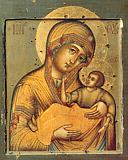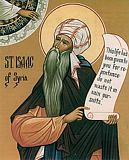

| Previous day | Next day |
| Old Style
April 12
|
Tuesday |
New Style
April 25
|
| 2nd Week after Pascha. Commemoration of the Dead (Radonitsa). Tone 1. | No fast.
|
St. Basil the Confessor, bishop of Parium (754).
Hieromartyr Zeno, bishop of Verona (ca. 260). St. Isaac the Syrian, abbot, of Spoleto, Italy (550). Monk-martyrs Menas, David, and John, of Palestine (after 636). Virgin Anthusa of Constantinople (801). St. Athanasia the Wonderworker, abbess, of Aegina (860).
Deposition of the Cincture [Sash] of the Most Holy Theotokos in Constantinople (942).
St. Sergius II, patriarch of Constantinople (1019). St. Basil, bishop of Ryazan (1295). St. Acacius of Kapsokalyvia Skete, Mt. Athos (1730). Martyr Sabbas the Goth, at Buzau in Wallachia (372).
Repose of Archbishop Juvenal of Vilnius, Lithuania, monk of Optina Monastery (1904).
Thoughts for Each Day of the Year
According to the Daily Church Readings from the Word of God
By St. Theophan the Recluse

Tuesday. [Acts 4:1–10; John 3:16–21]
He that believeth not in the Son of God is condemned already (John 3:18). For what? For the fact that when light is all around, he remains in darkness, due to his love for it. Love of darkness and hatred of the light make him entirely to blame, even without his determining where the truth lies; because he who has sincere love for the truth will be led by this love from the darkness of deception to the light of truth. One example is the holy apostle Paul. He was a sincere lover of the truth, devoted with all his soul to what he considered to be true, without any self-interest. Therefore, as soon as he was shown that the truth lay not in what he considered to be true, that very moment he cast aside the old—which proved to be untrue—and cleaved with all his heart to the new, which was tangibly proven to be the truth. The same occurs with every sincere lover of truth. The truth of Christ is clear as day: seek and ye shall find. Help from above is always ready for one who sincerely seeks. Therefore, if someone remains in the darkness of unbelief, it is only due to his love for that darkness, and for this he is already condemned.
Articles
 Hieromartyr Zeno the Bishop of VeronaSaint Zeno, Bishop of Verona, was born a Greek and came from Syria. In his youth he became a monk and devoted himself to the study of Holy Scripture. |
 Monk-martyrs Menas, David, and John, of PalestineThey were martyred in the seventh century by Arabs. |
 The Venerable Anthusa of ConstantinopleThe holy princess Anthusa of Constantinople was the daughter of the Iconoclast emperor Constantine Copronymos (reigned 741-775) and his third wife Eudokia. |
 Venerable Athanasia the Abbess of AeginaSaint Athanasia was abbess of a monastery on the island of Aegina in the ninth century. |




